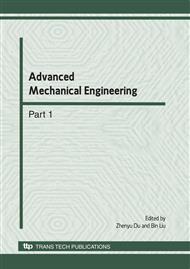[1]
D.R. Rohrmus. Invariant and adaptive geometrical texture features for defect detection and classification. Pattern Recognition. vol. 38-2(2003), p.1546.
DOI: 10.1016/j.patcog.2005.02.004
Google Scholar
[2]
F. Tajeripour, E. Kabir and A. Sheikhi. Defect Detection in Patterned Fabrics Using Modified Local Binary Patterns. International Conference on Computational Intelligence and Multimedia Applications. vol. 2(2007), p.63.
DOI: 10.1109/iccima.2007.50
Google Scholar
[3]
A. Kumar. Neural network based detection of local textile defects. Pattern Recognition. vol. 36(2003), p.1645.
DOI: 10.1016/s0031-3203(03)00005-0
Google Scholar
[4]
G.H. S Arunkumar, F. Eric. Statistical approach to unsupervised defect detection and multiscale localization in two-texture images. Optical Engineering. vol. 47-2(2008), p.20.
DOI: 10.1117/1.2868783
Google Scholar
[5]
Chung-feng Jeffrey KUO, Chung-yang, SHIH, et al. Automatic Recognition of Fabric Weave Patterns by a Fuzzy C-Means Clustering Method. Textile Research Journal. vol. 74-2(2004), p.107.
DOI: 10.1177/004051750407400204
Google Scholar
[6]
Du-Ming Tsai, Chih-Chia Kuo. Defect detection in inhomogeneously textured sputtered surfaces using 3D Fourier image reconstruction. Machine Vision and Applications, vol. 18-6(2007), p.383.
DOI: 10.1007/s00138-007-0073-3
Google Scholar
[7]
K.L. Mak and P. Peng. An automated inspection system for textile fabrics based on Gabor filters. Robotics and Computer-Integrated Manufacturing. Vol. 24-6(2008), p.359.
DOI: 10.1016/j.rcim.2007.02.019
Google Scholar
[8]
Chang-Chiun Huang and Tong-Fu Lin. Image Inspection of Nonwoven Defects Using Wavelet Transforms and Neural Networks. Fibers and Polymers. vol. 9-5(2008), p.633.
DOI: 10.1007/s12221-008-0099-9
Google Scholar
[9]
HE Feng LI Liqing XU Jianming. Woven fabric density measure based on adaptive wavelets transform. Journal OF Textile Research. vol. 28-2(2007), p.32.
Google Scholar
[10]
HOU Biao LIU Feng JIAO Li-cheng BAO Hui-dong. A Multiscale Texture Image Segmentation Algorithm Based on Adaptive Window Fixing and Propagation. Acta Electronica Sinica. vol. 37-7(2009), p.1492.
Google Scholar
[11]
HAN Li-wei XU De WANG Lin-kun. Adaptive Detection of Fabric Flaw Based on Statistical Information. Chinese Journal of Electron Devices. vol. 31-3(2008), p.979.
Google Scholar


